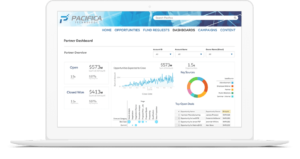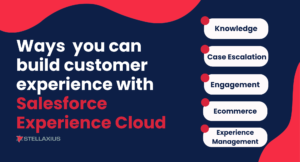Table of Contents
Staying connected with customers is as vital as ever, and with Salesforce Experience Cloud, you will be heightening your customer experience.
83% of customers expect to interact with someone immediately when they contact a company, and 78% of customers have used multiple channels to start and complete a transaction. — State of the Connected Customer Report
01
of 05
What is Salesforce Experience Cloud?
Salesforce Experience Cloud, formerly known as Salesforce Community Cloud, is a tool that allows businesses to build branded online communities and self-serve portals for their customers, partners, and employees. It enhances engagement, collaboration, and overall user experience.
You can choose what to show your clients by customising your company’s branding. For instance, your clients can access the community if you’re a B2B business using Salesforce Experience Cloud.

Take this example:
- You’re a Telecom company using Salesforce Experience Cloud for your clients. You use it for them to access new service order requests, report service issues, access open/closed support cases, and access billing invoices.
- Now, your customer has a centralized view of their purchases and a better relationship with your company, making it your point of contact.
- Another way this Telecom company is heightening its customer experience is by using bots to free its agents.
- Bonus points? A centralized platform now enables this Telecom company to access its customers’ history, facilitating more personalized communication with them.
02
of 05
Salesforce Experience Cloud Best Features
Now that we’ve given you the details of what Salesforce Experience Cloud consists of, let’s get into its elements. Here are a few key features that you should know about it:

-
Customer interaction boost
You can manage personalized badges and skill endorsements with Experience Cloud to recognize active community members and their abilities.
Let’s say you run a community forum for photographers. You can recognize active members who give helpful advice by awarding them a “Top Mentor” badge and allowing other users to endorse their photography skills. This personalizes the experience and incentivizes interaction.
-
Personalized experiences
Use CRM data to segment markets and deliver tailored experiences to achieve optimal segmentation of target markets, audiences and users. For example, if you have an e-commerce website, you can use customer purchase history to recommend complementary products. For instance, someone who buys a camera might be shown recommendations for camera bags or memory cards.
-
Response management optimization
You can consolidate brand information from various sources into a single experience, making it easier to organize conversations, files, groups, and experts. A social media team managing multiple platforms can use a tool that consolidates all comments and messages from Facebook, X, and Instagram into one central location. This streamlines responses and avoids duplicate efforts.
-
Real-time tracking
Customizable Lightning dashboards in Experience Workspace allow you to measure, process, and analyze data from your sites to optimize brand experiences. For example, a business running a marketing campaign with a landing page can use a dashboard to track the number of people visiting the landing page, how long they stay, and what links they click. This allows for real-time adjustments to optimize the campaign’s effectiveness.
-
Pre-built templates
As we will show throughout this article, you get access to a variety of pre-built templates. These allow you to choose one instead of starting a web project from scratch and customize it to match your business’ brand. Also, using the available point-and-click tools, you can create a partner portal without the need to code.
Let’s say your company wants to create a new website to showcase its services. Experience Cloud offers pre-built website templates for various industries, such as consulting, healthcare, and education. These templates provide a strong foundation with established layouts, menus, and content sections. The company can then customize the template with its own branding elements (colours, logos, fonts) and add specific content about its services.
-
Data integration
Experience Cloud allows the integration of data from any source. You can build a single source of truth for your customers by displaying data obtained from Salesforce (such as Leads, Opportunities, Cases, Campaigns and custom objects), third parties or legacy sources.
If your company uses multiple systems to manage customer data, Experience Cloud allows it to integrate data from both Salesforce and its website analytics tool. This creates a “single source of truth” where customer information is unified. For example, website visits can be linked to specific customer profiles in Salesforce, providing a more complete picture of customer interactions.
-
Analytics for decision-making
Reports and dashboards can be made available for both Customer Plus Community users and Partner Community users.

Imagine you’re a non-profit organization that runs a fundraising campaign with a website donation portal. Experience Cloud allows the creation of reports and dashboards that track key metrics like website traffic, donation amounts, and donor demographics. These insights can be used to understand what content resonates with donors and optimize the campaign for better fundraising results.
-
Personalized design for different devices
Optimize your business’s digital experiences by using fully functional templates for mobile devices with an easy and intuitive interface. For example, a company wants to create a mobile app for its customers to access account information and make purchases.
Experience Cloud offers pre-built mobile app templates optimized for screen sizes and touch interactions. The company can customize the template with branding and functionalities specific to their business needs. This ensures a seamless and user-friendly experience for customers on mobile devices!
03
of 05
What to Build with Salesforce Experience Cloud
Salesforce Experience Cloud is built within the world’s #1 CRM, Salesforce. With it, you can create a digital experience for your customer by presenting an external-facing interaction, such as partner portals, storefronts, support sites, customer service hubs, microsites, account portals, industry solutions, help centres, and mobile apps. For this article, we’ll focus on these 5:

-
Partner Portal
Experience Cloud offers a secure platform to manage partner access and data where you can define user roles and permissions, ensuring that partners only see the information relevant to their needs. The platform also scales to accommodate a growing number of partners without compromising performance. It connects your company with partners, letting you share data, collaborate, and manage leads – all in one place.
-
Storefronts
A storefront refers to a customer-facing website where buyers can explore products, make purchases, and handle their accounts. These storefronts enable you to:
- Sell products directly to your customers through a secure and user-friendly interface.
- Showcase your product catalogue with detailed descriptions, images, and videos.
- Offer promotions and discounts to incentivize purchases.
- Implement a shopping cart and checkout process for a seamless buying experience.
- Manage customer accounts and orders within the storefront.
-
Support sites
You can build support sites, often called customer portals or help centres, can provide a variety of functionalities, including:
- Knowledge Base: A searchable repository of articles, FAQs, and other resources that customers can use to find answers to their questions.
- Community Forums: A platform for customers to connect with each other, ask questions, and share solutions.
- Case Submission: A way for customers to submit support tickets and track their progress.
- Live Chat: A real-time chat option for customers to connect with support agents.
-
Customer service hub
The Customer Service Hub is a pre-built template available in Experience Cloud. It’s a powerful and responsive solution designed specifically for self-service needs. It comes with features like:
- Multiple pre-built themes to customize the look and feel of your portal.
- Search functionality to help customers easily find the information they need.
- Knowledge base integration to provide easy access to articles and other resources.
- Community forums for customer interaction and knowledge sharing.
- Embedded Service for offering live chat and agent collaboration features within the portal.
-
Microsites
Microsites are small, focused websites built within Experience Cloud. They’re ideal for specific campaigns, product launches, or targeted audiences. Here are some use cases for microsites:
- Event registration microsite to capture registrations and provide event details.
- Product launch microsite to showcase a new product and generate interest.
- Contest or giveaway microsite to promote a specific campaign and collect entries.
Microsites can leverage the same design elements and functionalities as your main Experience Cloud site but with a more targeted focus.
04
of 05
Building Customer Experience with Salesforce Experience Cloud
Now that you know some of the benefits of this platform and what you can build in it, we should get into the ways you can turn these benefits into building a better customer experience and customer relationship. We’ve gathered 5 ways you can enhance your customer experience with knowledge, case escalation, engagement, e-commerce and experience management. Let’s get into them.

-
Knowledge
By providing a library of knowledge articles and Q&A, customers can easily find answers to their queries without needing to contact a support agent. This streamlined system not only increases customer satisfaction but also reduces the number of calls, emails, and support requests your agents receive.
Additionally, this approach enhances not only the customer experience but also the productivity of your agents. They can quickly access and deliver the right answers to customers and even contribute to the knowledge base to ensure that the best answers are always available to the entire team.
-
Case Escalation
Customers can create cases and post questions in the community. Cases can be escalated automatically based on keywords or unanswered questions, which agents can choose to respond to within the community or privately. The most helpful answers can be voted up by users.

-
Engagement
Creating ranks, badges, and scoring systems is an effective way to incentivize community members to be more active. You can also encourage users to design their own badges and allow members to endorse each other as experts on specific topics. Customer Engagement software can be used to create a public leaderboard to acknowledge and thank members for their contributions.

-
E-commerce
Create a seamless shopping experience for customers by integrating your e-commerce platform and offering them a one-stop-shop for product discovery, research, and purchase, all in a single, branded, mobile, and social environment.
-
Experience Management
Preconfigured and customizable Lightning dashboards in the experience management console help you measure and analyze metrics such as adoption and engagement, as well as the most popular groups, users, and topics.

05
of 05
How Stellaxius Can Help
In conclusion, Salesforce Experience Cloud is a valuable business tool to improve customer experience and engagement. It allows companies to create branded online communities and self-serve portals for their customers, partners, and employees.
By providing features like a knowledge base and case management, Experience Cloud empowers customers to find answers, solve problems, and connect with each other, all while reducing the load of support agents. With its focus on personalization, data integration, and mobile accessibility, Experience Cloud can be a powerful asset for businesses in today’s digital landscape.
At Stellaxius, we are experts in preparing crucial questions that ensure your roadmap aligns seamlessly with Salesforce Experience Cloud. We evaluate Salesforce’s capabilities specific to your company’s context. So, if you’re ready to get started, contact us today to begin your journey with Experience Cloud.






